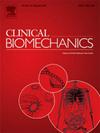Investigating postural control as a predictor of low back and pelvic girdle pain during and after pregnancy
IF 1.4
3区 医学
Q4 ENGINEERING, BIOMEDICAL
引用次数: 0
Abstract
Background
Falls are common during pregnancy, posing risks to maternal and fetal health. Pregnant individuals also commonly experience low back and/or pelvic girdle pain. Other populations with pain, such as older adults with back pain demonstrate increased fall risk. This study assessed the relationship between standing balance control characteristics during single leg stance and low back/pelvic girdle pain scores during and after pregnancy with eyes open and closed. We hypothesized that standing balance control characteristics of smaller sway and sway velocity would be related to greater low back/pelvic girdle pain during the third trimester.
Methods
During the second trimester, third trimester, and postpartum nineteen individuals performed single leg stance on a force platform with eyes open and closed and completed the Quebec Back Pain Disability Scale. Stepwise multiple linear regressions were used to investigate the variance of Quebec Back Pain Disability Scale scores that could be explained by postural control variables for each time point and condition.
Findings
During the third trimester, decreased total sway and anterior/posterior sway range with eyes closed were significantly associated with higher low back/pelvic girdle pain disability scores (P = 0.005, R2 = 0.480). No significant relationships were found during the second trimester or postpartum nor for eyes open conditions.
Interpretation
This study suggests a potential association between low back/pelvic girdle pain and postural control during pregnancy. Pregnant individuals with lumbopelvic pain may demonstrate postural stability deficits, particularly without visual input. Balance assessments and interventions should be considered during routine care for pregnant individuals, especially for those with pain.
将姿势控制作为孕期和产后腰背和骨盆疼痛的预测因素进行研究。
背景:怀孕期间摔倒很常见,会给孕妇和胎儿的健康带来风险。孕妇通常也会感到腰背和/或骨盆腰部疼痛。其他患有疼痛的人群,如患有背痛的老年人,也会增加跌倒的风险。本研究评估了单腿站立时的站立平衡控制特性与孕期和产后睁眼和闭眼时腰部/骨盆腰部疼痛评分之间的关系。我们假设,在妊娠三个月期间,摇摆幅度较小和摇摆速度较快的站立平衡控制特征将与腰背/骨盆腰部疼痛加剧有关:方法:19 名孕中期、孕晚期和产后妇女分别在睁眼和闭眼的情况下在受力平台上进行单腿站立,并完成魁北克腰痛残疾量表。采用逐步多元线性回归法研究了每个时间点和条件下姿势控制变量可解释的魁北克背痛残疾量表评分差异:结果:在妊娠三个月期间,闭眼时总摇摆幅度和前后摇摆幅度的减小与腰背/骨盆腰部疼痛残疾评分的升高显著相关(P = 0.005,R2 = 0.480)。在妊娠后三个月或产后,以及睁眼状态下,均未发现明显关系:本研究表明,孕期腰背/骨盆疼痛与姿势控制之间存在潜在联系。患有腰椎骨盆疼痛的孕妇可能会表现出姿势稳定性缺陷,尤其是在没有视觉输入的情况下。在对孕妇,尤其是有疼痛的孕妇进行常规护理时,应考虑对其进行平衡评估和干预。
本文章由计算机程序翻译,如有差异,请以英文原文为准。
求助全文
约1分钟内获得全文
求助全文
来源期刊

Clinical Biomechanics
医学-工程:生物医学
CiteScore
3.30
自引率
5.60%
发文量
189
审稿时长
12.3 weeks
期刊介绍:
Clinical Biomechanics is an international multidisciplinary journal of biomechanics with a focus on medical and clinical applications of new knowledge in the field.
The science of biomechanics helps explain the causes of cell, tissue, organ and body system disorders, and supports clinicians in the diagnosis, prognosis and evaluation of treatment methods and technologies. Clinical Biomechanics aims to strengthen the links between laboratory and clinic by publishing cutting-edge biomechanics research which helps to explain the causes of injury and disease, and which provides evidence contributing to improved clinical management.
A rigorous peer review system is employed and every attempt is made to process and publish top-quality papers promptly.
Clinical Biomechanics explores all facets of body system, organ, tissue and cell biomechanics, with an emphasis on medical and clinical applications of the basic science aspects. The role of basic science is therefore recognized in a medical or clinical context. The readership of the journal closely reflects its multi-disciplinary contents, being a balance of scientists, engineers and clinicians.
The contents are in the form of research papers, brief reports, review papers and correspondence, whilst special interest issues and supplements are published from time to time.
Disciplines covered include biomechanics and mechanobiology at all scales, bioengineering and use of tissue engineering and biomaterials for clinical applications, biophysics, as well as biomechanical aspects of medical robotics, ergonomics, physical and occupational therapeutics and rehabilitation.
 求助内容:
求助内容: 应助结果提醒方式:
应助结果提醒方式:


